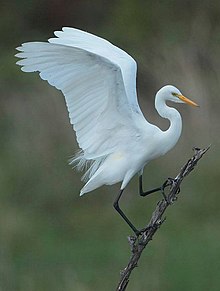
The great blue heron is a large wading bird in the heron family Ardeidae, common near the shores of open water and in wetlands over most of North and Central America, as well as far northwestern South America, the Caribbean and the Galápagos Islands. It is occasionally found in the Azores and is a rare vagrant to Europe. An all-white population found in south Florida and the Florida Keys is known as the great white heron. Debate exists about whether these white birds are a color morph of the great blue heron, a subspecies of it, or an entirely separate species.

Herons are long-legged, long-necked, freshwater and coastal birds in the family Ardeidae, with 72 recognised species, some of which are referred to as egrets or bitterns rather than herons. Members of the genera Botaurus and Ixobrychus are referred to as bitterns, and, together with the zigzag heron, or zigzag bittern, in the monotypic genus Zebrilus, form a monophyletic group within the Ardeidae. Egrets do not form a biologically distinct group from herons, and tend to be named differently because they are mainly white or have decorative plumes in breeding plumage. Herons, by evolutionary adaptation, have long beaks.

The grey heron is a long-legged wading bird of the heron family, Ardeidae, native throughout temperate Europe and Asia, and also parts of Africa. It is resident in much of its range, but some populations from the more northern parts migrate southwards in autumn. A bird of wetland areas, it can be seen around lakes, rivers, ponds, marshes and on the sea coast. It feeds mostly on aquatic creatures which it catches after standing stationary beside or in the water, or stalking its prey through the shallows.

The purple heron is a wide-ranging heron species. It breeds in Africa, central and southern Europe, and southern and eastern Palearctic. The Western Palearctic populations migrate between breeding and wintering habitats whereas the African and tropical-Asian populations are primarily sedentary, except for occasional dispersive movements.

The great egret (Ardea alba), also known as the common egret, large egret, or great white egret or great white heron, is a large, widely distributed egret. The four subspecies are found in Asia, Africa, the Americas, and southern Europe. Recently, it has also been spreading to more northern areas of Europe. Distributed across most of the tropical and warmer temperate regions of the world, it builds tree nests in colonies close to water.
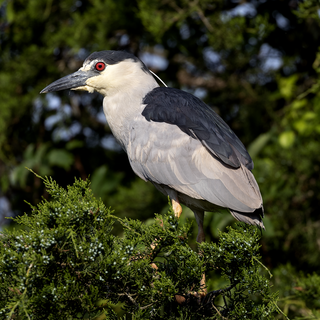
The black-crowned night-heron, or black-capped night-heron, commonly shortened to just night-heron in Eurasia, is a medium-sized heron found throughout a large part of the world, including parts of Europe, Asia, and North and South America. In Australasia it is replaced by the closely related nankeen night-heron, with which it has hybridized in the area of contact.

The little egret is a species of small heron in the family Ardeidae. It is a white bird with a slender black beak, long black legs and, in the western race, yellow feet. As an aquatic bird, it feeds in shallow water and on land, consuming a variety of small creatures. It breeds colonially, often with other species of water birds, making a platform nest of sticks in a tree, bush or reed bed. A clutch of three to five bluish-green eggs is laid and incubated by both parents for about three weeks. The young fledge at about six weeks of age.

The cattle egret (Bubulcus) is a cosmopolitan genus of heron found in the tropics, subtropics, and warm-temperate zones. According to the IOC bird list, it contains two species, the western cattle egret and the eastern cattle egret, although some authorities regard them as a single species. Despite the similarities in plumage to the egrets of the genus Egretta, it is more closely related to the herons of Ardea. Originally native to parts of Asia, Africa, and Europe, it has undergone a rapid expansion in its distribution and successfully colonised much of the rest of the world in the last century.

The western reef heron, also called the western reef egret, is a medium-sized heron found in southern Europe, Africa and parts of Asia. It has a mainly coastal distribution and occurs in several plumage forms: a slaty-grey plumage in which it can only be confused with the rather uncommon dark morph of the Little egret ; a white form which can look very similar to the little egret although the bill tends to be paler and larger and the black form with white throat E. g. gularis of West Africa. There are also differences in size, structure and foraging behaviour. There have been suggestions that the species hybridizes with the Little Egret, and based on this, some authors treat schistacea and gularis as subspecies of Egretta garzetta. Works that consider the Western Reef Heron as a valid species include the nominate gularis and schistacea as subspecies.

The white-faced heron also known as the white-fronted heron, and incorrectly as the grey heron, or blue crane, is a common bird throughout most of Australasia, including New Guinea, the islands of Torres Strait, Indonesia, New Zealand, and all but the driest areas of Australia.
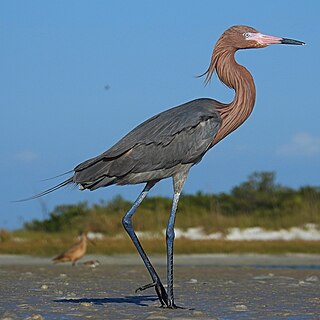
The reddish egret is a medium-sized heron that is a resident breeder in Central America, the Bahamas, the Caribbean, the Gulf Coast of the United States, and Mexico. The egret is known for its unusual foraging behavior compared to other herons as well as its association with mud flats, its habitat of choice.

The little blue heron is a small heron of the genus Egretta. It is a small, darkly colored heron with a two-toned bill. Juveniles are entirely white, bearing resemblance to the snowy egret. During the breeding season, adults develop different coloration on the head, legs, and feet.

The medium egret, median egret, smaller egret or intermediate egret, is a medium-sized heron. Some taxonomists put the species in the genus Egretta or Mesophoyx. It is a resident breeder in southern and eastern Asia.
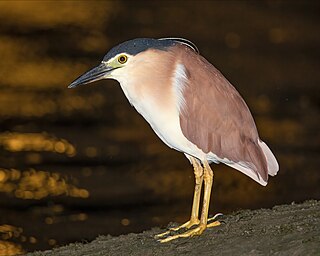
The nankeen night heron is a heron that belongs to the genus Nycticorax and the family Ardeidae. Due to its distinctive reddish-brown colour, it is also commonly referred to as the rufous night heron. It is primarily nocturnal and is observed in a broad range of habitats, including forests, meadows, shores, reefs, marshes, grasslands, and swamps. The species is 55 to 65 cm in length, with rich cinnamon upperparts and white underparts. The nankeen night heron has a stable population size, and is classified as a species of least concern by the International Union for Conservation of Nature (IUCN).

Ardea is a genus of herons. These herons are generally large in size, typically 80–100 cm or more in length.

The rufous-bellied heron is a species of heron in the genus Ardeola, the pond herons, of the family Ardeidae. It is found in southern Africa.

The eastern great egret is a species of heron from the genus Ardea, usually considered a subspecies of the great egret. In New Zealand it is known as the white heron or by its Māori name kōtuku. It was first described by British ornithologist John Edward Gray in 1831.

The eastern cattle egret is a species of heron found in the tropics, subtropics and warm temperate zones. Most taxonomic authorities lump this species and the western cattle egret together as subspecies of the cattle egret, but some separate them. Despite the similarities in plumage to the egrets of the genus Egretta, it is more closely related to the herons of Ardea. It is native to southern and eastern Asia, and Australasia.
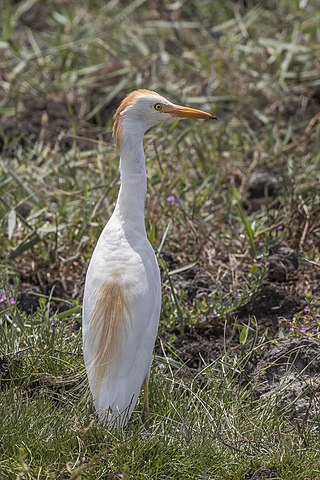
The western cattle egret is a species of heron found in the tropics, subtropics and warm temperate zones. Most taxonomic authorities lump this species and the eastern cattle egret together, but some separate them. Despite the similarities in plumage to the egrets of the genus Egretta, it is more closely related to the herons of Ardea. Originally native to parts of Asia, Africa and Europe, it has undergone a rapid expansion in its distribution and successfully colonised much of the rest of the world in the last century.
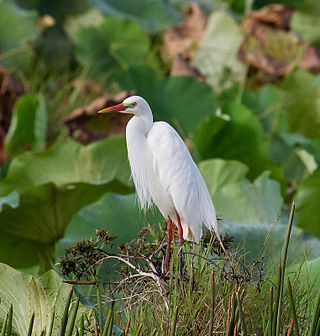
The plumed egret is a species of heron native to Australia and Oceania. Previously this species was regarded as a subspecies of the intermediate egret alongside the Asian intermediate egret and the African yellow-billed egret.
